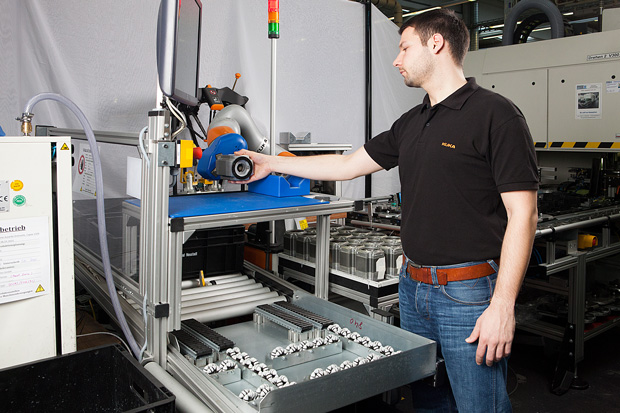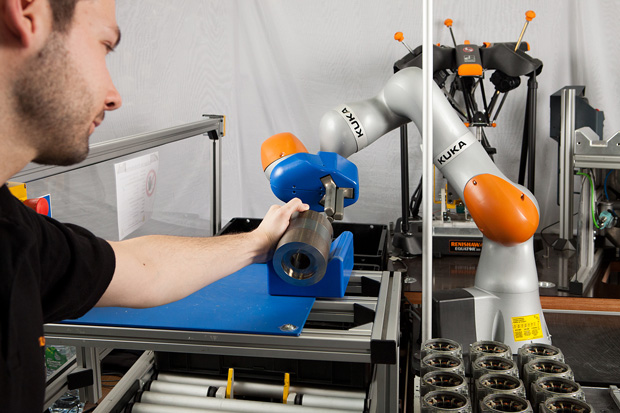
The solution of a “Knight concept” allows KUKA’s robots to be implemented or removed as needed. Image courtesy of KUKA.
August 1, 2016
The motion control business unit of the Siemens Digital Factory (DF) division, with its headquarters in Erlangen, specializes in producing high-performance motors, inverters and controllers. With an extensive range of comprehensively integrated hardware and software as well as technology-based services, the DF division helps production companies all over the world to boost the flexibility and efficiency of their manufacturing processes, and to bring new products to market faster.
In the town of Bad Neustadt an der Saale, Siemens operates a lead factory for electric motors. There, among other items, the drives for numerous KUKA robots are produced. With the expertise derived from hundreds of thousands of electric motors and employing a workforce of about 1,700 people, the lead factory is an innovative example for electronics with the “made in Germany” cachet.
 The solution of a “Knight concept” allows KUKA’s robots to be implemented or removed as needed. Image courtesy of KUKA.
The solution of a “Knight concept” allows KUKA’s robots to be implemented or removed as needed. Image courtesy of KUKA.For its stator manufacturing operation, the company was on the lookout for a flexible solution to automate the simple activity of passing on and positioning workpieces which had previously been done by hand — while retaining the high quality and continuous, barrier-free access to the working area for people. Together with the Augsburg-based company, KUKA Systems GmbH, and its Advanced Technology Solutions department, a flexible cell was developed for this application using KUKA’s LBR iiwa lightweight robot. Its sensitive capabilities make this robot weighing less than 30 kg ideal for human-machine collaboration. With its seven axes, it is not only more agile and more mobile than most models of its kind, it also features torque sensors in all axes, making the robot sensitive — as a result of which it can also detect obstacles in the room and respond accordingly.
In the Siemens plant in Bad Neustadt, the robot functions as a roving multitasker (Knight) mounted on a carriage with the task of taking the part to be processed — the stator consisting of a basic body made from punched magnetic steel sheet and an aluminum bearing plate — out of a workpiece carrier and supplying it to a lathe for machining the stators. But that is not all: the robot is also used for the quality check. It grips the machined parts and scans the barcode. After the workpieces have been cleaned by blowing them with air, the lightweight robot feeds them to the measuring station in a tilting device. If there are any deviations, they are found there. Thanks to networked technology, precise measurement and identification of each component makes it possible to calculate immediately whether a correction is required, and this can be implemented in the system. In line with the Industry 4.0 philosophy, the system consequently organizes itself. After that, the robot places the part in a plastic box so it can be delivered.
Parts that have to be recalibrated in the machine are placed into a buffer that is defined as the “HRC zone,” for human-robot collaboration. Here, the safe technology means the worker can be in the same area as the robot and, if required, remove parts and workpieces or change them. Jochen Weber, the man in charge of the product launch and developing production technology at the lead factory, explains: “At first, we were thinking about having the process carried out by a conventional industrial robot.”
 Siemens’ Digital Factory division is advancing human-robot collaboration for more efficient electric motor production. Image courtesy of KUKA.
Siemens’ Digital Factory division is advancing human-robot collaboration for more efficient electric motor production. Image courtesy of KUKA.However, this would have meant building a protective fence around the cell for safety reasons. “We wanted more flexibility, though, so that the worker can also intervene at any time and take over from the robot depending on the situation,” he says.
As a result, the decision was taken to use a flexible LBR iiwa lightweight robot combined with the KUKA solution of a “Knight concept.” This allows the robot to be deployed or simply moved away depending on the situation.
Torsten Franz, project manager in the technology development team, adds: “An HRC application was also something new for us. We wanted to use the system as a learning tool ourselves, allowing us to bootstrap our development incrementally. This has been very successful in the joint project with KUKA. The solution is convincing.”
In this way, KUKA is proving that robot automation and high flexibility are not mutually exclusive. Using sensitive robot technology makes human-robot collaboration possible. As a result, the enclosure that used to be required can be dispensed with, as can additional sensors for parts detection.
Subscribe to our FREE magazine, FREE email newsletters or both!
About the Author
DE’s editors contribute news and new product announcements to Digital Engineering.
Press releases may be sent to them via [email protected].
Related Topics






